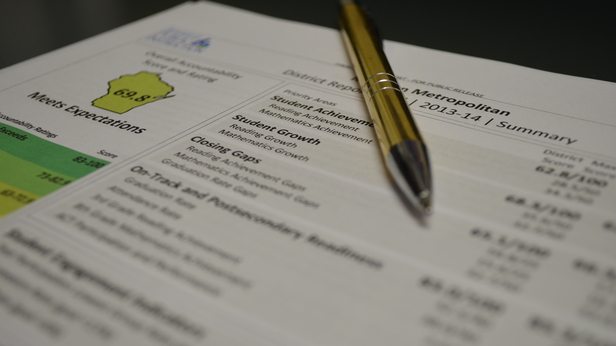
Milwaukee Public Schools Score, on Average, 20 Points Worse Than the Statewide Average
September 16, 2014
by Christian D’Andrea
MacIver Institute Education Policy Analyst
The Department of Public Instruction (DPI) released the latest School Report Cards on Tuesday, allowing Wisconsinites to get a better look at the performance of their local public schools. The average report card score rose by half a point in 2013-14 thanks in part to fewer deductions in Wisconsin’s classrooms for problems like high school dropouts and high absentee rates.

This was the third year that data was reported for the state’s School Report Cards, but since changes were made after the pilot year in 2011-12, our comparisons will be limited to the past two years. These grades are based on student performance in grades 3-10 in four different categories. Those are: student achievement, student growth, closing gaps, and postsecondary readiness. Schools are also subject to deductions from their overall score if they fail to meet state benchmarks for attendance, test participation, and dropout rates.

Only one district fell in the “Fails to Meet Expectations” range. That was Milwaukee, whose score of 51.1 was 4.8 points lower than the next-worst district (Bayfield). Only one of the state’s 20 largest districts, Elmbrook, earned the equivalent of an “A” grade in 2013-2014.

15 of the state’s 20 largest districts saw their School Report Card scores rise in 2013-14. Madison, Eau Claire, Wausau, Sun Prairie and Elmbrook all saw gains of a full point or more in the past school year. Conversely, Janesville, West Allis-West Milwaukee and West Bend all saw their scores drop by the same margin.

Superintendent Tony Evers pointed out that these higher scores may be the product of fewer point deductions that were related to student behavior. Only six of the state’s 424 districts earned five-point deductions for absentee rates, low test participation, or having a high concentration of dropouts. Evers praised this performance but warned that there’s still work to do in Wisconsin’s public schools in this morning’s release.
“Most of our public schools and school districts are providing a solid education to our children, but we don’t want to rest on our laurels,” said the Superintendent. “These report cards are a good communication device to focus discussion among parents, schools, and communities on how our schools and school districts are doing and how they can continue to improve.”
These higher scores are a step forward for Wisconsin’s schools. This year’s improvement on state metrics may help ease concerns over the discussed use of the School Report Cards as a measuring stick for sanctioning consistently underperforming schools and rewarding/replicating consistently strong ones. We’ll have a more in-depth breakdown of these marks – including what they mean for the state’s charter school population – as the week wears on.